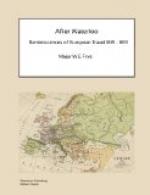The Opera House, a building in the Grecian taste erected by Frederic the Great with the inscription Apollini et Musis, and after that the Academy of the Fine Arts engaged my attention. Both these buildings are remarkable, and they are near the Linden. The old town is much intersected by canals communicating with the Spree which divides it. I call it the old town, to distinguish it from the quarter composed of streets of recent construction between the former enceinte of the town and the Brandenburger Thor. The Hotel of the Invalides, a ponderous building, bears the following inscription: Laesis non victis. The Bank and the Arsenal next engaged my attention, as also a Guard House of recent construction in the shape of a Doric temple. The Royal Palace is an immense building, partly in the Gothic and partly in the Grecian style. It is very heavy but imposing. The interior of this Palace is royally fitted up, except the little room occupied by the great Frederic, which is left in the same state as when he occupied it; and you know he was not fond of superfluous ornament. In the green before the Palace stands the statue of the Prince of Anhalt Dessau, the founder of the Prussian Infantry system, and at a short distance from this, on the Lange Bruecke, stands the colossal equestrian statue in bronze of the Great Elector.
The Koenigstrasse is the principal street and a very fine one it is; next to it in point of beauty is the Franzoesische Strasse. The Wilhelm Platz is adorned with the statues in marble of Schwerin, Seidlitz, Keith, Winterfeld, and Ziethen. But I cannot enumerate all the splendid public establishments and fine things to be seen in this beautiful city. The most striking church is that of St Hedwig. I call it the most striking from its resemblance to the Pantheon at Rome. The Cathedral is perhaps a finer building. ’Tis in this last that the Electoral and Royal remains are deposited.
The streets ’here swarm with military, and indeed the profession of arms seems to have too much sway in the Prussian dominions. The subalterns and young men of the Prussian Army are said to have republican sentiments, and they, in common with all the burghers, desire a constitution. It galls them to see one enjoyed by the Bavarians, whom they affect to look upon as inferior to them in intelligence, and that it should be refused to them. Most of the nobility and the greater part of the General and field officers are however inveterate aristocrats.
You have heard, I dare say, of the attempt made by some officers among the nobility to exclude from the service, after the peace, those officers who were not noble. When it is considered that their best and most zealous officers sprung from the burghers, and that Prussia, when abandoned by her King and nobles, was saved from permanent subjection only by the unparalleled exertions of her burghers and peasantry, one is shocked




